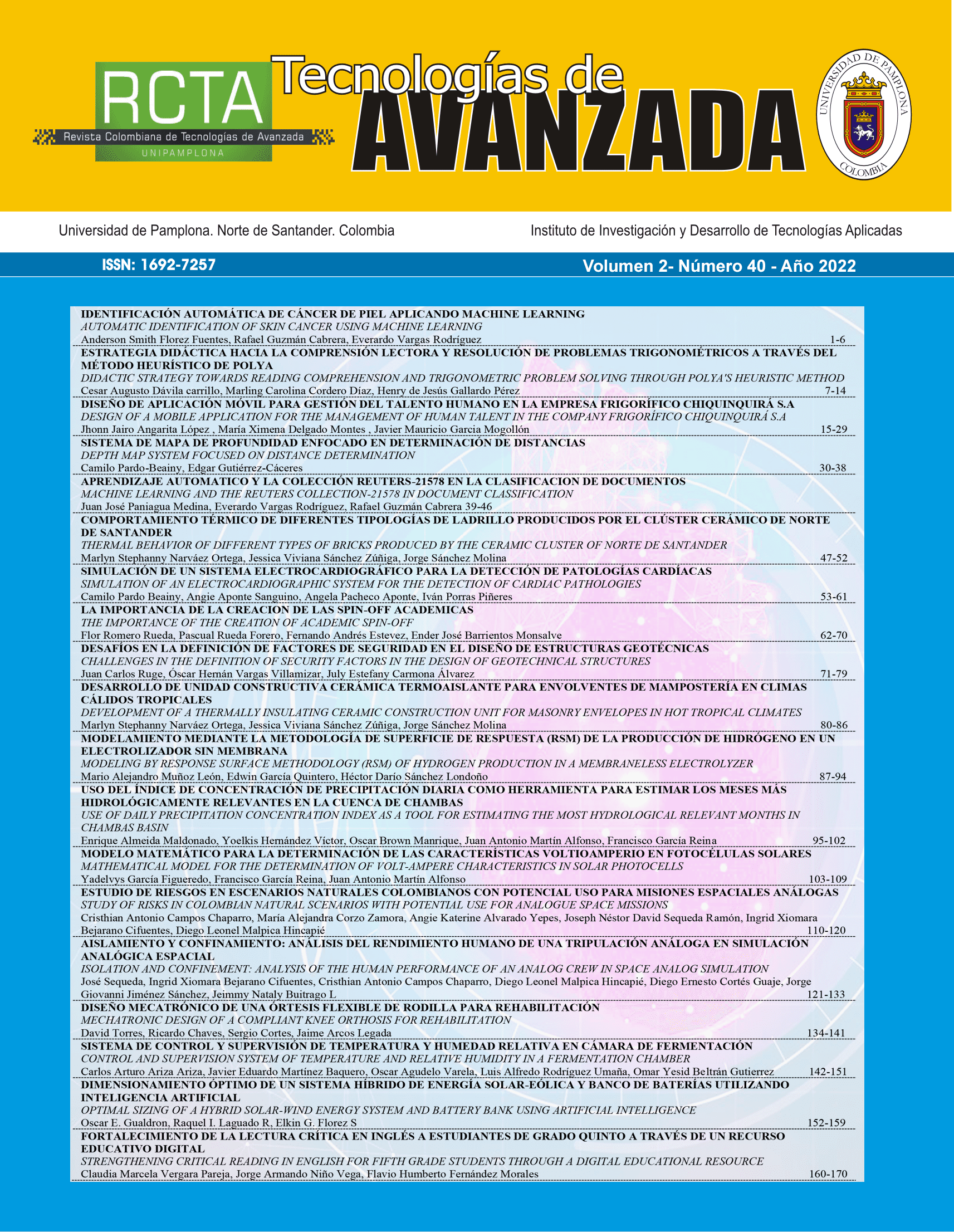Isolation and confinement: analysis of the human performance of an analog crew in space analog simulation
DOI:
https://doi.org/10.24054/rcta.v2i40.2360Keywords:
analog missions, isolation, confinement, cognitive developmentAbstract
Crew members on analog missions participate in simulated space missions that experience isolation and confinement in order to educate and conduct science, technology, engineering, and other experiments. These analog crew members are typically students or individuals seeking careers in space science and industry. This article describes the first lunar analog simulation carried out by military professionals from the Colombian Air Force, a mission that was designed to provide efficient training for future operations that are aimed at developing the national astronaut training program in Colombia. The THOR (Team of Human Operation Research) mission was carried out in August 2022, with the support of a Mission Control Center (MCC), a seven-day analog isolation and confinement mission whose objective was to promote cognitive development, physical, physiological, psychological and technological during this simulated space mission. The THOR mission was the 50th mission of the Analog Astronaut Training Center (AATC), it was divided into a crew within the habitat composed of 5 analog crew members with specific roles based on their experience, background and appropriate to the roles provided by the AATC , and two additional external crew members who provided remote support and external investigation. During the mission period, tests such as spatial learning, working memory, abstraction, sensory-motor speed, spatial orientation, emotion identification, abstract reasoning, risk decision making, team dynamics, quality and quantity of sleep, were performed. Fatigue scores, R-R interval, using wrist actigraphy and anthropometry, psychomotor alertness, time perception, and critical habitat tasks were measured by simulating a short mission to the lunar surface using the NASA-TLX survey, as well as the Brainess mobile apps. and Subjective Time Perception. Subjects were exposed to cryotherapy and accelerations.
Downloads
References
Bendak, S., & Rashid, H. S. J. (2020). International Journal of Industrial Ergonomics Fatigue in aviation A systematic review of the literature. International Journal of Industrial Ergonomics, 76(February), 102928. https://doi.org/10.1016/j.ergon.2020.102928
Brinkmann, W., Cordes, F., Ernst, C., Koch, S., Wirkus, M., Dettmann, A., Thomas, V., & Kirchner, F. (2019). Space Robotic Systems and Artificial Intelligence in the Context of the European Space Technology Roadmap Space Robotic Systems and Artificial Intelligence in the Context of the European Space Technology Roadmap. November.
Cinelli, I. (2020). CLASSIFICATION OF ANALOGUE MISSIONS A REFERENCE FOR MISSION DESIGN AND IMPLEMENTATION.
Cromwell, R. L., Huff, J. L., Simonsen, L. C., & Patel, Z. S. (2021). Earth-Based Research Analogs to Investigate Space-Based Health Risks. New Space, 9(4), 204–216. https://doi.org/10.1089/space.2020.0048
Filcek, M. (2022). Innovative Vinci Power Nap® Neurotechnology System—To Reset and Reconnect the Senses, Body and Mind Reducing Stress, Improving Performance, Sleep, Health and Quality of Life BT - Resilient and Responsible Smart Cities (H. Abdalla, H. Rodrigues, V. Gahlot, M. Salah Uddin, & T. Fukuda (eds.); pp. 249–264). Springer International Publishing.
Geiger, L., Popp, M., Färber, B., Artigas, J., & Kremer, P. (2010). The Influence of Telemanipulation-Systems on Fine Motor Performance. 2010 Third International Conference on Advances in Computer-Human Interactions, 44–49. https://doi.org/10.1109/ACHI.2010.46
Glaros, Z. L. (2020). Influence of Night Work on Performance during Lunar Telerobotic Operations.
Holding, B. C., Sundelin, T., Lekander, M., & Axelsson, J. (2019). Sleep deprivation and its effects on communication during individual and collaborative tasks. Scientific Reports, 9(1), 1–8. https://doi.org/10.1038/s41598-019-39271-6
Hussain, S. A., Salim, A., & Al, A. (2020). A real time face emotion classification and recognition using deep learning model A real time face emotion classification and recognition using deep learning model. https://doi.org/10.1088/1742-6596/1432/1/012087
Inoue, N., & Tachibana, S. (2013). An Isolation and Confi nement Facility for the. 867–871. https://doi.org/10.3357/ASEM.3188.2013
Lindert, B. H. W. Te, & Someren, E. J. W. Van. (2018). Skin temperature , sleep , and vigilance. In Thermoregulation Part I (1st ed., Vol. 156). Elsevier B.V. https://doi.org/10.1016/B978-0-444-63912-7.00021-7
Mallis, M. M., & DeRoshia, C. W. (2005). Circadian rhythms, sleep, and performance in space. Aviation, Space, and Environmental Medicine, 76(6 Suppl), B94-107.
R. J. Arnegard, & J. R. Comstock Jr. (1991). Multi-Attribute Task Battery - Applications in pilot workload and strategic behavior research. NASA Technical Reports Service.
S. D. Mhatre. (2021). Neuro-consequences of the spaceflight environment. Neurosci. Biobehav. https://doi.org/10.1016/j.neubiorev.2021.09.055.
Saltin, B., & Ra, G. (1998). Skeletal muscle blood ow in humans and its regulation during exercise. 1.
Steimle, H., & Norberg, C. (2021). Astronaut selection and training. https://doi.org/10.1007/978-3-642-23725-6
Wu, B., Wang, Y., Wu, X., Liu, D., Xu, D., & Wang, F. (2018). On-orbit sleep problems of astronauts and countermeasures. 1–12.
Downloads
Published
Versions
- 2022-07-25 (6)
- 2022-07-25 (5)
- 2022-07-25 (4)
- 2022-08-07 (3)
- 2023-07-19 (2)
- 2023-05-02 (1)
How to Cite
Issue
Section
License
Copyright (c) 2022 REVISTA COLOMBIANA DE TECNOLOGIAS DE AVANZADA (RCTA)

This work is licensed under a Creative Commons Attribution-NonCommercial 4.0 International License.














